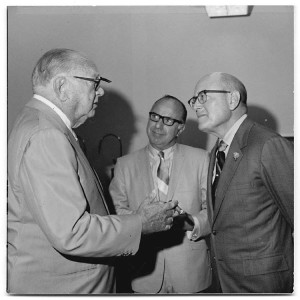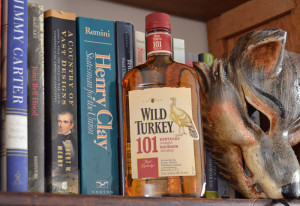Q&A With Bourbon Empire Author Reid Mitenbuler
By Kurt Maitland

Making a long story short, I ran into Reid Mitenbuler at a tasting. I’ve seen his work before and dove into his book right after. For me, it’s one of the best books on American whiskey that I’ve had the pleasure to read this year. I had to catch up with Reid to bombard him with questions about the book and here are his responses.
KM: So how did you get into writing about whiskey?
RM: I was a whiskey nerd, but often found myself drawn to the history of the industry as much as the liquid. My goal was always to write a book about it. American whiskey has all the elements of an epic business tale: politics, economics, craft, hucksterism. It’s like that movie, There Will be Blood, but with booze instead of blood. As a symbol, whiskey’s also a shapeshifter: it’s both rebellious and Establishment, refined and trashy, agricultural and industrial. I wanted to write something that captured all those things. It’s also a funny story, courtesy of a lot of goofy marketing that, at the end of the day, has its own special charm.
KM: How long did it take for you to finish the research and the writing of Bourbon Empire and what did you find were the most helpful sources?
RM: I started collecting bits and pieces of research about a decade ago, as a weekend hobby. Then it spread to weeknights. Then it became like a mission to drag Kurtz out of the jungle. Once I had a book deal, I worked on it full-time for about a year, but I’m a slow writer. My rule was to leave most of my research on the cutting-room floor and keep the story from getting too weedy. Research came from everywhere—interviews and conversations, other books on tangential topics, various archives. My favorite sources were old newspapers and magazines. I wrote it while living in DC and used the Library of Congress a lot. The librarians there are national treasures.
KM: In reading the book, you show the readers a rich tapestry of characters involved in the story of Bourbon. Which characters stood out to you and why?
RM: I love the business titans who made their bones during Prohibition and ruled the industry for decades afterward, particularly Lewis Rosenstiel and Sam Bronfman, who controlled over half the whiskey in the country as they prowled around offices on Park Avenue and in the Empire State Building. I mean Rosenstiel had enough juice to pressure the Joseph McCarthys and J. Edgar Hoovers of the world, while Bronfman decorated the Seagram headquarters with the hide of a Bengal tiger rumored to have devoured 84 men.
That’s all pretty baller, but despite the whiskey industry’s love of exaggerated storytelling, these guys’ pictures don’t show up on any bottles. The reasons are obvious—both were prickly and controversial, horrible for marketing—and their memories are fading, despite their vast importance and influence. I’m drawn to exploring those kinds of contradictions. When I discussed these men with fellow history nerds I often heard the same thing: “those guys were just corporate raiders, not distillers.” Fair enough, but I’d argue that their legacies are stronger than those of many people who did make it onto bottles, they just don’t fit central casting’s idea of who should be associated with a product so deeply connected to American heritage.

(Credit: University of Miami)
But as unromantic as it sounds, I think whiskey’s business side is joined at the hip with its culinary-craftsmanship side. Guys like Rosenstiel and Bronfman were directly responsible for many things you taste in the glass today, or don’t taste, considering the consolidation rounds they presided over. Rosenstiel was the prime driver behind the Forand Act in 1958, which allowed distillers to age more than eight years without having to pay taxes—it was a move to save his own butt following a ruinous business mistake he made that almost ruined a huge part of the entire industry. There it wasn’t about craft, it was about business, but it affected the craft. Inadvertently, this move gave him tons of old surplus, allowing him to jack up age statements and try to use them to promote the luxury aspect of whiskey, which was traditionally seen as rather blue-collar. He also lobbied for the 1964 resolution declaring bourbon a distinctive product of the United States—his intention not being to honor bourbon, as that resolution is remembered today, but to protect bourbon’s status in important overseas markets, to limit his competition. In any case, I think that resolution ultimately helped change people’s perception of bourbon, which had its own ripple effects on how the spirit is made and consumed, so that’s why I wanted to orient the book towards whiskey as a business.
It’s funny, Rosenstiel once owned a past incarnation of what is today Buffalo Trace Distillery. I asked an employee there about him and was met by a raised eyebrow, a tiny smile, and the comment, “In this industry, we really don’t like to talk about that guy.” Anyway, part of me admittedly likes to talk about these guys because I have raconteur’s blood in me, and I love the fact that the man who ran the town so brashly defy the soft-focus images you get from today’s marketing departments and foodie media, and made good whiskey to boot. I’m careful not to criticize it, though—in fact, I kind of enjoy celebrating that reality.
KM: Your book pulls off the rare feat of showing the reader both the business and the “mystique” sides of the bourbon industry. What did you find that surprised you as you researched the book?
RM: Whiskey’s “mystique” has a very real authenticity, especially when you anchor it in the powerful symbolism of events like The Whiskey Rebellion. My favorite “surprises,” though, were all the contrarian backstories.
For instance, whiskey advertising offers a lot of juicy fodder in that brand histories are often concocted out of thin air, which bothers some people today regarding brands like Templeton or Michter’s. But I like placing it in a historical context, showing how distillers like James Pepper were doing that sort of thing at the dawn of whiskey marketing. I love the irony that whiskey’s “authentic” history is a legacy of creating fake history. That’s not a criticism, it’s just an observation that all the puffery and jiggery-pokery are part of the industry’s DNA. I think it’s rather funny.
On the craftsmanship side, I like other contrarian truths that separate the business from the mystique. For instance, we love romanticizing ye olde ways, which do have merit, but there are so many unromantic things—big scale, technology, science—that not only help improve whiskey, but can also make it cheaper to produce. Knowing this helps consumers cut through some of the marketing fog.
Today, particularly in the burgeoning craft sector, a lot of mystique is attached to doing things on an “artisanal” small scale, posing in glossy food magazines dressed like early homesteaders, and bragging that you make whiskey in the noble traditions of ancient peoples who were shorter and lived closer to water. When this sort of thing is genuine, and it often is, I love it. Love it a lot. But I think this kind of buzzy craftspeak sometimes goes too far, and that’s when I like to push back a bit, especially when I think inefficiency is being fetishized simply to justify a higher price that the whiskey doesn’t live up to. Of course, this kind of sweet hustle has always been part of the industry’s DNA, so like everything else it comes full circle.
I also think it’s useful to remember—and this is what any economist with a pulse will tell you—that “comparative advantage,” “economies of scale,” and the thoughtful use of technology aren’t necessarily bad things. It’s a balancing act. I’m always a little disappointed when a distiller talks a big game—about being “local,” about working on a small scale, implying that all this gives him some kind of moral superiority—and then drives the whole train off a cliff by cutting some corner like aging their whiskey in a small barrel, thus murdering its potential greatness. I understand that this sort of compromise is made out of economic necessity, and I’m sensitive to that, but my palate’s not a charity organization either. I live in Brooklyn, which is an epicenter of what I like to ironically, if perhaps a bit cynically, call the “craft-industrial complex,” so I’m a little wary of situations where image trumps substance.
I also wanted to display a strong point of view about such things, albeit without getting mired in the inevitable squabbles of any passionate grouping of enthusiasts. I honor the truth that taste is subjective, but also remain aware that this argument can sometimes be used to justify lower standards. So I like taking a stance. If God’s a whiskey geek, and I’m pretty sure he is, then I like to think there’s a lost commandment buried somewhere on Mt. Sinai: “Thou shalt not mature whiskey in small barrels if you want that whiskey to be as excellent as possible.”
But that separation of mystique and business is my own personal rule of connoisseurship: drain out the romance and look at whiskey from a purely technical perspective. This makes me sound like a killjoy, though. If I owned a brand I wouldn’t be saying any of this stuff – I’d be winking and telling people that George Washington’s troops drank my brand, which is more fun.
KM: Having done so much research to write your book, are there any industry trends you foresee in the near future?
RM: I’m excited about Americans making single malts, which to me is the most interesting part of the craft movement right now. I like the idea of using smoke—like Darek Bell from Corsair talks about in his book Firewater—for an American take on Scotch. I also like to imagine how the Scots will talk about these American usurpers behind closed doors.
I also think we’re closing in on a lot more really good craft whiskey, although there’s still a ways to go—every year, expressions from the earlier generations of craft distillers noticeably improve. I like watching them fight the good fight. With that said, I think there’s going to be a lot of shuttered distilleries in the next few years. I suspect some recent entrants are undercapitalized—last year, I saw a new distillery bragging that it started on a kickstarter campaign of, like, $80,000. If I had the guts to do what these guys are doing, I’d want to start with at least one hundred times that.
I also think big established distilleries have carefully learned from Big Beer not to ignore changing consumer trends. Jim Beam and Buffalo Trace have poured a lot of money into experimenting more, so we’ll see interesting new products, like the Beam rolled oat whiskey from their Harvest Collection, from every sector of the industry.
KM: Are there any interviews, thoughts, etc. that you wish you could have included in this pressing of your book?
RM: Tons. As I said, I left lots of research on the cutting room floor. I would have liked to include more biographical details on some of the characters. I did a lot of research on Harvey Wiley, a driving force behind quality regulations leading up to the 1906 Pure Food and Drug Act, but cut 90% of it. His whole backstory is great. He was a bootstrapping Indiana farm boy whose parents instilled in him this crusading impulse to combine science with his deep religious beliefs to help improve mankind.
Same thing goes for Joseph Greenhut, the biggest distiller in the nation, and by some accounts the world, before Prohibition. This guy was born with nothing, killed a lot of people in the Civil War, and then he became a business titan with whole neighborhoods of 35-room mansions. He even loaned his Jersey Shore home out to Woodrow Wilson for use as a summertime White House. His fortune came on the back of sterile spirits that he sold to rectifiers, however, before he attempted to form a spirits cartel after the fashion of John D. Rockefeller’s Standard Oil. An archivist in Peoria let me read his will and some letters he wrote to his kids that he wrote in old age. He was one serious dude.
KM: We’ve spent all of this time talking about whiskey – what whiskeys do you like to drink and what ones do you want to learn more about?

(Credit: Richard Thomas)
RM: I have to admit, I have some blind spots in the Scotch world. Also, I’m really not trying to be cute when I say that I really do love a lot of ordinary standard stuff: Old Grand Dad, Very Old Barton, Wild Turkey. I bristle a little when people use terms like “table bourbon” or “value whiskey,” which can sometimes demean what these whiskeys truly offer. Those are the kinds of brands that got me into whiskey, what I first fell in love with.
Since I poke fun at the hoarding mentality in the book, I made an active decision a few years ago to drink (or gift) away my bunker, although I still keep a few special things on the backshelf. In the book, I argue that many of the “rules” of connoisseurship are all in our minds, so I’m kind of philosophically drawn to whiskey that’s available, consistent, and accessible, while realizing that you can also have some magical bottles outside that bubble. For me, I always like to remember where American whiskey came from, which is a pretty humble place.





Read the book!
It just reeks of the evolution of American Capitalism, from the perspective of the Whiskey Industry.
I recommend this book to anyone I meet who has an interest in Whiskey and American History.
Just fascinating and wonderfully written!